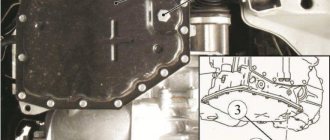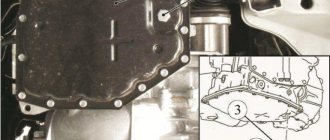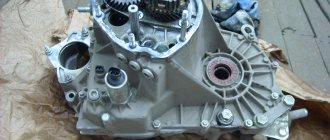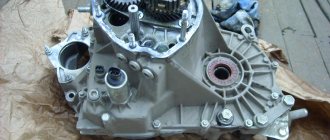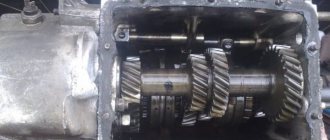Types of Lada Vesta gearbox
The car is represented by only two types of transmission units, providing sufficient comfort and vehicle dynamics. What is noteworthy is the introduction of our own technologies, rather than the use of imported components from competitors.
Robotic manual transmission
This unit is a modified design of a standard manual transmission. The main difference from typical schemes is considered to be completely new electronic support - the control unit independently performs the manipulations of shifting gears, depressing the clutch and decides at what speed to start. The advantages of robots over classic machines are the following:
- Resistance to wheel slip. This is especially necessary when driving on snowy or muddy roads. Automatic transmissions tend to overheat when the drive pair of wheels slips.
- Using lower grade lubricants. For mechanical blocks there is no need to fill in high-quality formulas, since there are no pumps or filter elements.
- Fewer moving parts - this design is more reliable due to its simple design.
- Minimum weight. Complex automation components have an impressive weight, which increases the load on the suspensions and the overall weight of the car.
- Support for tractor modes. AMT is not afraid of increased overloads when towing other vehicles on a flexible hitch.
- Economical - the torque converter creates additional friction inside the structure. This increases fuel consumption and takes away some of the power from the power plant. Also, the absence of such a complex part allows us to minimize the amount of necessary lubrication.
- Dynamics. A robot is an automated mechanic. In other words, when creating a product, the practicality and price of classic manual transmissions are preserved.
- There is no need to warm up the engine for a long time - I sat down and drove off.
Among the disadvantages, users identify standard problems with such installations:
- rolling back of the car when starting downhill;
- failures during switching;
- transmissions are connected late (stubby).
The complete diagram of the unit is not disclosed by the manufacturer due to personal reasons. However, it is known that on this model, the car takes the first hundred in 14.1 seconds, which is far from the ideal result of its competitors. However, market experts claim the high reliability of the units - the domestic gearbox can travel up to 500,000 km without major repairs and this is an impressive result.
Mechanics
The first batch of cars that rolled off the assembly line came with a French 5-speed manual transmission. This decision was due to shortcomings in our own model, which exhibited increased noise during switching. However, a year later, the shortcomings were eliminated, and the car ran on a domestic block marked 21807. After the rework, the engineers removed extraneous noise and vibration, increased torque, which contributed to better performance during acceleration and the absence of failure to “lock up” the revolutions. Acceleration to hundreds has also improved - Renov’s analogue made it possible to reach 100 km/h in 11.2 seconds. Our design handles acceleration 1 second faster. The maximum speed has also increased from 175 to 188 km/h. However, the locally made gearbox is inferior to its analogue in terms of efficiency - 7.5 liters versus 6.9.
Note! There is a simple way to determine the type of gearbox installed on a car. To do this, you need to study the VIN code of the car. The GFL 13 marking indicates the use of JH3-510 mechanics from Renault, GFL 12 is issued by the AMT robot, and GFL 11 indicates the presence of a domestic design 21807.
What to expect from Lada Vesta SW Cross with manual transmission
We boldly declare that the most anticipated car in our country in 2022 is the Russian Lada Vesta SW Cross station wagon, namely the all-terrain version. Let us remind you that the Cross differs from the standard station wagon in that it has increased ground clearance by 25 mm, the presence of plastic body protection all around, as well as richer equipment.
On our own behalf, we can add that when choosing between two cars, we would give preference to the Vesta SV Cross, because this car looks more interesting, and in terms of characteristics, the Cross is a little more attractive than its brother.
It is also worth considering that the all-terrain version is slightly more expensive than a regular station wagon; the difference in the price of the basic versions is about 116,000 rubles.
On our website we have already talked about the robot on Vesta SV Cross, today we would like to take a closer look at the versions equipped with a manual gearbox.
Whose mechanics?
Perhaps one of the main questions among potential owners is the question related to the manual transmission, or rather, is there a French or Russian gearbox on the new Lada Vesta St. Cross station wagon of the 2022 model year? This question is very relevant, because...
The first versions of the Vesta sedan were equipped with French transmissions, then in order to reduce the cost of the car, Vesta began to be equipped with Russian gearboxes. This raises a reasonable question: is Russian or foreign mechanics installed on the SV cross.
We managed to find out from AvtoVAZ representatives that the car is equipped with a French 5-speed manual JR5 from Renault (the main pair is 4.212).
It is worth noting that the Lada Vesta sedan is equipped with two mechanical transmissions, the first made in Russia, the second made in France. You can understand which transmission a car is equipped with by looking at the engine index.
The Russian box has the index VAZ-21179-01 (Vesta MT 21807), while the French one is called 21179-50 (Vesta MT JR5-515).
The disadvantages of the JR5 gearbox from Renault are the high price compared to the domestic design, there are problems with engaging reverse gear, and noisy operation (box whine).
Price and engine options
Now we invite you to talk about which engines come with a manual gearbox, as well as the cost of the Lada Vesta SV Cross station wagon in 2022:
1.6 liter petrol engine with 106 horsepower
- Luxe price from 755,900 rubles;
- Luxe Multimedia price from 779,900 rubles;
1.8 liter petrol engine with 122 horsepower
- Luxe price from 780,900 rubles;
- Luxe Multimedia price from 804,900 rubles;
- Luxe Prestige price from 822,900 rubles.
Alternative, what to choose for this money?
Agree, it’s difficult to realize that the cost of a domestic car can be more than 800,000 rubles. Probably every car owner will think several times about what new cars he can buy for this amount, besides Vesta.
It is noteworthy that SW Cross simply has no competitors in this segment; many will choose between Vesta SV Cross and Solaris, Rio, Polo sedan and Rapid. Of all the above, we would give preference to Rapid, because The trunk of a Czech car is more spacious, and there is the option of choosing an automatic transmission.
Not many journalists mention that for the amount of 890,000 rubles you can buy a Renault Duster crossover with a 2.0 liter gasoline engine and all-wheel drive. Yes, of course, the Duster will be more expensive, but you will get all-wheel drive.
Another alternative is to consider purchasing the Chinese crossover Chery Tiggo 2
This model, in our opinion, also has a very attractive interior and exterior design; moreover, the technical parameters of the Chinese crossover and the domestic station wagon are similar.
Both cars have plastic body protection, high ground clearance and front-wheel drive. Chery Tiggo 2 is equipped with a 1.5 liter petrol engine producing 106 hp.
The price of a car in Russia, depending on the configuration, varies between 598,000 – 789,900 rubles.
This list may also include a huge list of Chinese crossovers whose price will be comparable to the all-terrain version of the station wagon.
I don’t like Chinese cars, ok, as an alternative you can consider the Korean crossover Hyundai Creta
Yes, of course, it will be a car with a basic configuration and front-wheel drive, but you will receive a 5-year warranty, a 1.6 liter gasoline engine and a 6-speed manual transmission, a high seating position, an attractive design and, most importantly, reliability.
What kind of oil is in the box of Lada Vesta
For manual transmissions and AMT blocks, the manufacturer uses lubricants of the type TM-4-12 SAE 76W-85 GL-4. The use of GL-5 category lubricants is not recommended due to the presence of brass elements. The highest grade contains an increased amount of anti-wear additives that can damage the structure. In this case, the optimal viscosity is selected from the 75W90 standard.
Technical characteristics of popular Liqui Moly oils
Since the company’s product range is very extensive and continues to expand, it makes sense to provide a description of the features and technical characteristics of the most popular oils for different types of transmissions.
Hochleistungs-Getriebeoil 75W80
Hochleistungs-Getriebeoil 75W80 oil is intended for use in robotic preselective gearboxes. Provides quick engagement and disengagement of friction clutches, optimal functioning of hydraulic servos, high-quality lubrication of synchronizers, gears and other transmission parts. Features of Hochleistungs-Getriebeoil 75W80 liquid:
- almost ideal viscosity-temperature properties;
- excellent shear stability;
- high wear resistance;
- excellent antioxidant properties, resistance to aging.
Specifications:
- viscosity index at a temperature of 40° C – 33.00 mm2/s;
- viscosity index at 100° C – 6.85 mm2/s;
- viscosity index at a temperature of -40° C – no more than 20,000 mPas;
- ignition temperature – 200° C;
- critical crystallization temperature – minus 48° C.
Top Tec MTF 75W80
Top Tec MTF 75W80 oil is used in mechanical gearboxes, power take-off units and transfer cases. Recommended for use in manual transmissions from most well-known car manufacturers. It is characterized by a high degree of protection of transmission components from wear.
Features of Top Tec MTF 75W80 fluid:
- ensuring fuel efficiency;
- excellent anti-corrosion properties;
- resistance to high loads;
- decent viscosity-temperature parameters;
- ensuring optimal operation of synchronizers.
Specifications:
- viscosity index at a temperature of 40° C – 53.60 mm2/s;
- viscosity index at 100° C – 9.30 mm2/s;
- viscosity index at a temperature of -40° C – no more than 150,000 mPas;
- ignition temperature – 202° C;
- critical crystallization temperature – minus 45° C.
Getriebeoil 85W90
Getriebeoil 85W90 is a GL4 class mineral transmission fluid intended for use in manual transmissions of trucks and passenger vehicles. It is characterized by the use of base mineral components of the highest quality and a complex of additives and modifiers that ensure clear and fast gear shifting.
Features of Getriebeoil 85W90 oil:
- possibility of use in gearboxes with all types of bevel and cylindrical gears;
- full compatibility with all modern seals;
- all-season use.
Specifications:
- viscosity index at a temperature of 40° C – 197.00 mm2/s;
- viscosity index at 100° C – 17.60 mm2/s;
- viscosity index at a temperature of -12° C – no more than 150,000 mPas;
- ignition temperature – 220° C;
- critical crystallization temperature – minus 15° C.
Hypoid-Getriebeoil TDL 75W90
Transmission oil Hypoid-Getriebeoil TDL 75W90 is a semi-synthetic fluid designed for filling into manual transmissions of passenger and heavy vehicles, drive axle gearboxes and transfer cases. It features high-quality protection of transmission parts from wear and ensures clear and fast gear shifting.
Features of Hypoid-Getriebeoil TDL 75W90 fluid:
- wide range of temperature conditions;
- ability to provide high temperature and viscosity stability;
- Possibility of use in highly loaded transmissions.
Technical characteristics of gear oil Liqui Moly 75w90 Hypoid-Getriebeoil TDL:
- viscosity index at a temperature of 40° C – 81.20 mm2/s;
- viscosity index at 100° C – 14.20 mm2/s;
- ignition temperature – 180° C;
- critical crystallization temperature – minus 43° C.
Hochleistungs-Getriebeoil 80W90
Hochleistungs-Getriebeoil 80W90 is a synthetic fluid of class GL-4/5, intended for filling into manual transmissions of passenger cars, including models in which the transmission is coupled to the final drive. The oil ensures clear and fast gear shifting and effective protection of transmission parts from wear.
Liqui Moly Hochleistungs-Getriebeoil 80w90 gear oil has the following special properties:
- excellent temperature-viscosity properties;
- effective protective action against corrosion and wear;
- possibility of use in highly loaded transmissions;
- easy gear shifting.
Specifications:
- viscosity index at a temperature of 40° C – 77.00 mm2/s;
- viscosity index at 100° C – 14.00 mm2/s;
- viscosity index at a temperature of -40° C – no more than 150,000 mPas;
- ignition temperature – 215° C;
- critical crystallization temperature – minus 42° C.
Selection of analogues
Typically, the selection of consumables begins with determining the type of lubricant base. As of 2022, there are three categories.
- Mineral. The products are manufactured by distilling crude oil, allowing for easy purification from foreign contaminants. Due to the use of outdated technology and the absence of depressant additives, the formulas provide a minimal degree of protection of the unit from natural wear and are susceptible to high-temperature oxidation and mechanical destruction. Low cost is considered a plus.
- Semi-synthetic. This variety is recommended by the factory as the best option for servicing Lada Vesta. The production technology involves saturating the mineral base with modern synthetic additives. This approach guarantees sufficient strength of the protective film, resistance to temperature oxidation, and, as a result, a long operating time. The disadvantages include moderation in all respects - the mixture will not provide excellent protection in a single parameter.
- Synthetics. The third type is a combination of advanced technologies in 2022. Typically, the product base is obtained by synthesizing natural gas molecules to isolate complex hydrocarbon chains and then compress them. Or the use of PAO structures of polyalphaolefin compounds obtained from natural oil (rapeseed, coconut). No compromises provide maximum reliability, cleanliness and increased protective properties. Also relevant here is the introduction of innovative friction modifiers, depressant components, which reduce the temperature threshold for operating the formula down to -50 degrees Celsius. The only drawback is the high price - for 1 liter of real synthetics you can buy up to 3 liters. cheaper substance.
The list of recommended analogues includes the following liquids:
- Elf Tranself NFJ;
- TM-4-12 SAE;
- RAVENOL Getriebeol PSA;
- Total Dual 9FE;
- Castrol Syntrans Transaxle.
Note! The data is for informational purposes only. The final choice of product depends on the personal preferences of the car owner.
Why does liquid waste its potential?
The lubricant contains the main component of oil refining and a set of specialized additives. During operation of the machine, the liquid gradually loses the necessary characteristics and reduces efficiency indicators, which leads to the following negative changes:
- the appearance of unpleasant noise or knocking;
- structural parts lose their properties;
- the mechanism begins to spontaneously switch off gears or does not work quite clearly;
- The main gear and additional elements may fail.
The operating time of transmission oil directly depends on the driving habits of the car. The service life can be halved if the owner allows himself to be aggressive on the roads, starting with slipping. This puts significant pressure on gearbox components and leads to their rapid wear.
Most Lada Vesta buyers think about replacing the factory fluid with a better one after 4-5 thousand km. mileage because they don’t trust it. Changing the oil in the automatic transmission would be necessary if the “automatic” was built into the VAZ new product, but it is characterized only by “robot” and “mechanics”. The installation of an automated box is expected for future expensive modifications from VAZ.
When to change the oil in Lada Vesta
The standard service interval for a vehicle's gearbox is 45,000 km. However, the gap is relevant for moderate use without serious loads on the transmission. During hard use, it is necessary to reduce the clearance to 30,000 km. Experts also recommend replacing lubricants when the following signs appear:
- Extraneous noise. The box began to howl and hum.
- The appearance of vibrations and dullness during switching.
- Fluid leaks through seals.
- During a routine check, the lubricant darkened greatly and lost viscosity.
Important! If metal shavings or dust are found on a sample of motor oil, simply refilling a new portion of the mixture will not help - a major overhaul of the gearbox is required.
What does oil viscosity affect?
The viscosity of transmission oil has a great influence on the vehicle's gearbox. With high viscosity, delays in gear shifting may occur, the sliding time of gearbox components increases, which increases wear, but reduces the noise of the gearbox. Oil, on the contrary, with low viscosity is not able to create a strong film between surfaces. So, if it is destroyed, the elements begin to work “dry”, which contributes to wear.
You can easily feel the viscosity of the oil in winter at very low temperatures when starting the car.
Changing the oil in a robot is a bit of a difficult task, because... the factory did not provide for this operation. To replace, you will need a large syringe for pumping oil.
It's no secret that changing the oil in the Lada Vesta gearbox is a very important procedure, on which not only the correct operation of the gearbox depends, but also its service life. Yes, the oil in a manual gearbox ages much longer than in the same automatic transmission or CVT. But this does not mean that it does not need to be changed at all. Today we will figure out how to do all the work ourselves, what is required for this and when the procedure will need to be repeated. So, let's go!
Changing the oil in manual transmission Lada Vesta
The sequence of actions when servicing a manual transmission unit looks like this:
- Drive a car 10 km to warm up the contents - the need is caused by the thickening of the mixture during idle time.
- Drive the car onto a flat surface, overpass or lift.
- Remove the crankcase compartment protection.
- Prepare 2.3 liters of fresh lubricant, a container for testing.
- Unscrew the plastic plug for the inspection hole.
- Unscrew the drain screw at the bottom of the housing.
- Wait until the waste drains completely.
- Reinstall the plug.
- Using an additional hose, pour the required volume of lubricant through the control hole.
After completing the procedure, you need to drive the car for about 10-15 km to break in the new formula.
